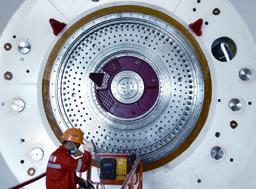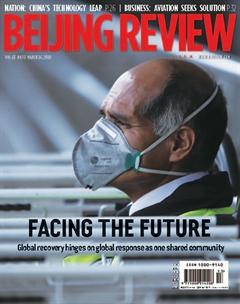A DOUBLE BLESSING
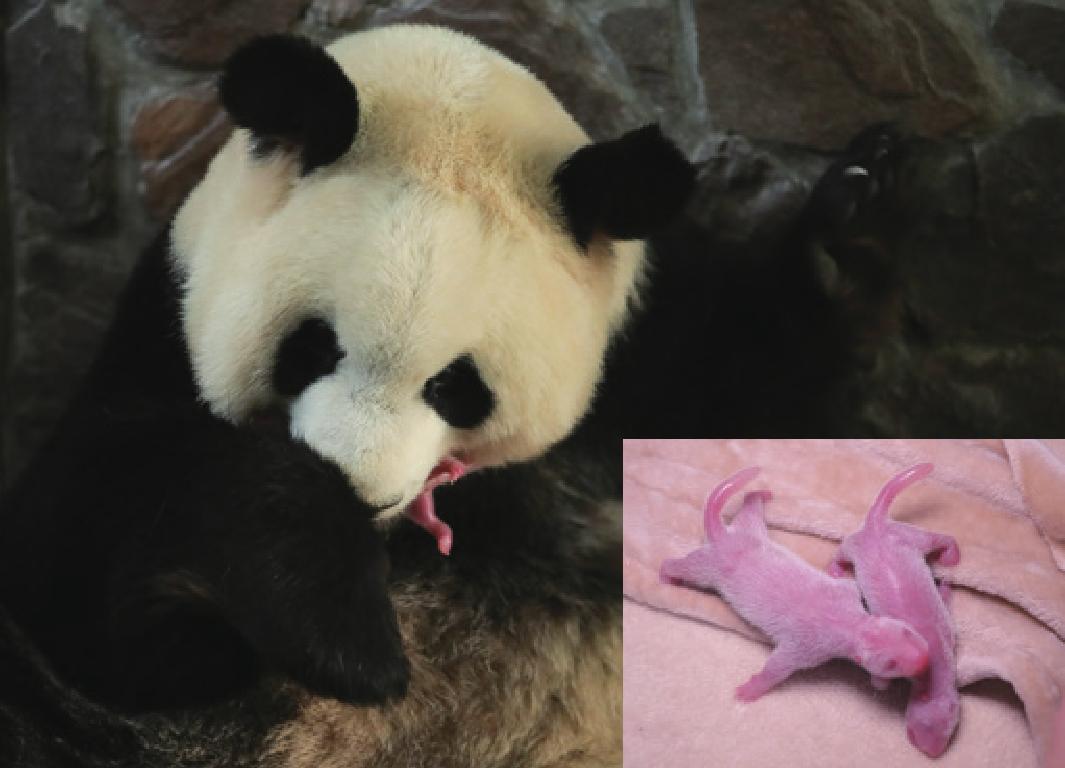
(Inset) Giant panda Fuwas newborn twins at the China Conservation and Research Center for the Giant Panda in Chengdu, Sichuan Province, southwest China, on March 17. (Top) Fuwa with one of her cubs at the center.
The center welcomed the worlds fi rst pair of captive-bred giant panda twins on March 17. The male cubs weighed 159.8 and 119.5 grams, respectively. Both are healthy and doing well.
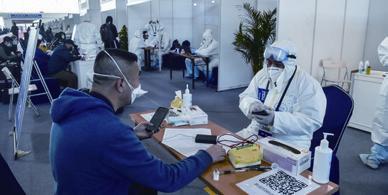
Transit Center
A staff member registers an inbound passengers information at the New China International Exhibition Center in Beijing on March 17. Beijing has converted the exhibition center into a transit center for inbound passengers from countries with high risks of COVID-19. The center, divided into different zones according to the destinations of passengers, is used for people showing no fever, cough or other symptoms during the health inspection at the airport.
Hospital Reopens
Over 600 medical workers from 22 Beijing hospitals have been assigned to work at the Xiaotangshan Hospital, which reopened on March 16 to treat patients with the novel coronavirus disease (COVID-19) amid the capitals mounting pressure to handle imported cases.
On March 16, the hospital tested 35 travelers transferred from the Beijing Capital International Airport, with one person from the United Kingdom testing positive for the virus, according to the Beijing Municipal Health Commission.
The hospital, located in the citys northern suburb, has more than 1,600 beds after renovation. It accommodates inbound travelers awaiting health screening as well as suspected and confi rmed patients with mild symptoms.
It was established in 2003 to treat patients with severe acute respiratory syndrome. Beijing started to renovate the hospital on January 30 as a precaution in the face of the novel coronavirus outbreak.
Some 15,000 people worked on the renovation, which was completed on March 15.
Vaccines on Anvil
Some vaccines for COVID-19 are expected to enter clinical trial in China as soon as possible, offi cials said at a press conference on March 17.
Chinese scientists have been racing to develop COVID-19 vaccines. Wang Junzhi, an academician with the Chinese Academy of Engineering, said vaccine safety is a priority in research and development.
So far, most teams are expected to complete preclinical research in April and some are moving forward faster, Wang said.
Lei Chaozi, an offi cial with the Ministry of Education, said one vaccine is currently under animal tests and is scheduled to apply for clinical trial by the end of April.
Animal testing for recombinant protein-based subunit vaccine is also underway. China is capable of producing high-quality and highpurity proteins for vaccines on a large scale, according to Lei.
For nucleic acid-based vaccines, Lei said China is stepping up studies based on past experience in combating Middle East respiratory syndrome-coronavirus and will speed up tests.
Some universities and colleges have also isolated COVID-19 antibodies from the blood of recovered patients, which will be able to provide three-week-long immunity.
Online Training
China will launch an online program to help teachers in middle and primary schools and kindergartens improve their online teaching ability amid the novel coronavirus outbreak, according to a newly issued circular.
The circular, jointly released by the Ministry of Education and the Ministry of Finance, said online training should be delivered fl exibly depending on the situation of the epidemic.
The circular said efforts should be ramped up to provide assistance to teachers in hard-hit areas.
In addition, it called for highquality resources to focus on supporting schools in remote poverty-stricken areas.
Stricter Rules
Shanghai requires 14 days quarantine for travelers who have been to or lived in any of 16 particular countries during the two weeks before entering the city. They are required to be quarantined at home or in designated facilities, the local government said at a press conference on March 17.
The 16 countries are the Republic of Korea, Italy, Iran, Japan, France, Spain, Germany, the United States, the United Kingdom, Switzerland, Sweden, Belgium, Norway, the Netherlands, Denmark and Austria.
The municipal government said it will adjust the list of countries and regions according to the global development of the epidemic.
Zeng Qun, Deputy Director of the Shanghai Municipal Bureau of Civil Affairs, said those who need to be quarantined should not live in the same apartment with those who are not under quarantine to reduce the risk of cross-infection. If the selfquarantine conditions do not meet quarantine requirements, passengers will be transferred to designated areas and their accommodation and food will be paid for.
All passengers from the 16 countries will be transported to temporary inspection sites to take nucleic acid tests before quarantine. Those with positive test results will be transferred to designated medical institutions for diagnosis and treatment.
Local police, health departments and community staff will implement stricter management measures to ensure that people in quarantine do not leave their residence. Those who leave without permission will be dealt with according to the law.
Green Production
Chinese authorities have unveiled a guideline to accelerate the establishment of laws, regulations and policies regarding green production and consumption.
Efforts will be made to promote cleaner production, resource recycling and end management amid the expansion of green product consumption, said the document jointly released by the National Development and Reform Commission and the Ministry of Justice on March 17.
By 2025, regulations and policies related to green production and consumption will be further improved, and an institutional framework with incentives and constraints will be put in place, said the document.
Green production and consumption patterns will be implemented in key areas and industries by then, with overall improvements in the countrys level of green development.
The country will develop a circular economy, with a focus on green production related to electrical, electronic and automobile products, power storage batteries, leadacid storage batteries and certain packaging materials. Producers will shoulder greater responsibility for recycling waste products.
The guideline also stressed measures to promote policy mechanisms for green design and to strengthen clean industrial production and industrial pollution control.
China will also take steps to promote clean energy development and green growth of agriculture and the service industry, among efforts to encourage a greener lifestyle, according to the document.

Concert in Field
Actors perform in a rapeseed fi eld in Wuyuan County, Jiangxi Province in east China, on March 16. The concert was held in the fi eld to give visitors a unique experience.
Pandas Online
As many of Chinas panda bases in Sichuan Province in the southwest were closed due to the novel coronavirus outbreak, local institutions have been livestreaming to keep global fans close to their beloved animal.
The livestreaming is the result of cooperation between the China Conservation and Research Center for the Giant Panda, which closed its four panda bases since January 25, and iPanda.com.
The contents on the site have been browsed over 700 million times globally since the bases were closed, with 200 million views of videos and 5 million interactions, according to the institution.
The livestreaming focuses on the daily activities of the giant bears in the bases. In one of the bases, the broadcasts received over 8 million views.
The site also opened a new column to show how keepers interact with the pandas, as well as the epidemic prevention and control efforts made in the bases.
“I spend some time watching what the pandas are doing every day. It relieves my anxiety and makes me laugh,”read one comment on the livestream platform.
“After the epidemic, Ill go to the bases to visit the bears I have been raising ‘online,” another said.

Museum Reopens
People visit the Shanghai Natural History Museum on March 13. The museum reopened that day after thorough disinfection. The number of visitors was restricted to 30 percent of the normal capacity for epidemic control.
Returning to Work
Hubei Province in central China, hit hard by the novel coronavirus outbreak, has started sending out workers after new infections petered out in most of its cities.
The cities of Jingzhou, Huanggang, Xianning and Qianjiang have arranged chartered vehicles to send out thousands of migrant workers at a time when factories across China are rushing to resume work amid a labor crunch.
On March 15, 49 chartered vehicles carrying 1,445 workers departed from Huanggang, which had reported no new cases for 13 days.
The city had recorded 2,907 confirmed cases of COVID-19.
Local officials said 750,000 migrant workers who returned home for the Spring Festival holiday have been stranded in Huanggang since travel restrictions were imposed to minimize infection risks.
The city government has contacted companies in the provinces of Guangdong, Zhejiang and Jiangsu to receive local workers, and sent police officers and medics to escort the chartered vehicles.
On the morning of March 15, another 72 workers from Qianjiang arrived in Shaoxing, Zhejiang Province in east China, after an 11-hour journey on four chartered buses.
“They will go through 14-day quarantine at a designated spot upon arrival. The Shaoxing Government will cover all the expenses incurred and provide them with daily necessities during the quarantine,” said Xuan Fangjun with Shaoxings human resources and social security bureau.
The Hubei Provincial Government has promised to issue health codes to facilitate personnel movement within Hubei and make arrangement to send workers directly from their homes to factories outside the province.
Export Rebate
China raised export rebate rates for 1,464 types of products starting on March 20.
The rebate rate for 1,084 products including ceramic sanitary ware was increased to 13 percent, and that for 380 goods including plant growth regulators to 9 percent, according to the Ministry of Finance and the State Taxation Administration.
Higher export rebate rates will facilitate foreign trade by lowering operating costs and easing cash shortages for manufacturers, Li Xuhong, a professor at the Beijing National Accounting Institute, said.
Bank Profits
A majority of listed banks reported robust net profi t growth in 2019, Economic Information Daily said on March 17.
As of March 16, 24 of the 36 listed banks on the A-share market had released preliminary earning results, with their total net profi ts reaching 439.1 billion yuan($62.7 billion), up 10.9 percent year on year.
Altogether 19 listed banks saw net profi t growth of more than 10 percent, the paper reported.
The forecasts came amid a solid expansion of the Chinese economy in 2019 when bankscapital adequacy ratio improved and their capability to serve the real economy and resist risks strengthened, Wen Bin, chief researcher with the China Minsheng Bank, told the paper.
Chinas listed banks have continuously improved their asset quality and profi tability, he added.
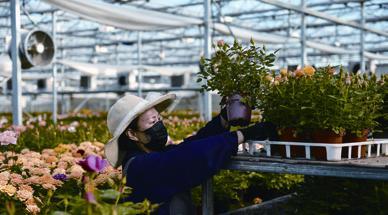
Flower Power
A staff member arranges fl owers in an industrial park in Taiyuan, Shanxi Province in north China, on March 14. As the demand for fl ower grows, local fl ower growers have increased production to ensure supply.
Targeted RRR Cuts
The Peoples Bank of China, the central bank, has implemented targeted reserve requirement ratio(RRR) cuts for eligible banks from March 16 to support the economy. The move has released 550 billion yuan ($78.57 billion) of long-term funds.
The cuts target inclusive fi nance, and banks that meet the criteria in inclusive fi nance can enjoy 50 to 100 basis points of RRR cuts. In addition, eligible jointstock commercial banks will be given an additional targeted RRR cut of 100 basis points to support lending in inclusive fi nance.
According to the central bank, it will help reduce the real interest rates of loans for small, micro and private enterprises and bolster the real economy more directly. The central bank will implement a prudent monetary policy in a fl exible and appropriate manner and give more attention to the recovery and development of the real economy. It will maintain rea- sonably suffi cient liquidity instead of engaging in a deluge of strong stimulus policies.
The growth of loans and social fi nancing should be in line with economic development to create an appropriate monetary and fi nancial environment for high-quality development and supply-side structural reform, it said.
This is the second time for China to implement RRR cuts this year. On January 1, the central bank announced it would cut the RRR for fi nancial institutions by 50 basis points from January 6, releasing about 800 billion yuan($114.19 billion) of long-term liquidity.
Steady Growth
The iron and steel sector in China saw overall stable growth in 2019, as the continued effort to cut overcapacity fi ltered through, according to the Ministry of Industry and Information Technology(MIIT).
The output of crude steel saw an 8.3-percent growth to stand at 996 million tons in 2019, marking a new all-time high, while pig iron output went up 5.3 percent from one year earlier to 809 million tons, data from the MIIT showed.
Driven by the rising market demand, the total consumption of crude steel across the country reached about 940 million tons, up 8 percent year on year.
The industry, however, reported remarkable shrinking in profi t led by factors like accelerated output growth, higher costs of raw materials as well as lower prices of steel products.
The aggregate profi t of China Iron and Steel Industry Association members totaled 189 billion yuan ($27 billion) in the past year, 30.9 percent lower than the previous year.
Meanwhile, the exports and imports of steel products contract-ed by 7.3 percent and 6.5 percent, respectively.
Aviation Efforts
The aviation industry in China will beef up efforts to curb the import of novel coronavirus cases, according to the Civil Aviation Administration of China (CAAC).
The administration has categorized fl ights into three levels of high, medium or low epidemic risk in accordance with factors including the epidemic situation of the departure countries, the passenger load and the conditions of the fl ights, Zhu Tao, an offi cial with CAAC, told a press conference on March 16.
Passengers will be managed in different areas and arranged to sit separately, and quarantine areas will be set in high-risk fl ights, Zhu said.
The Beijing Capital International Airport has designated a special zone for all international fl ights as well as fl ights from Hong Kong, Macao and Taiwan. All passengers disembarking from these fl ights are required to undergo health check-ups including temperature screening at checkpoints.
To bring Chinese citizens back home from the hard-hit countries, CAAC has carried out seven transportation missions, bringing back 1,101 people. Nine experts have fl own abroad along with nearly 90 tons of supplies in six fl ights to aid other countries fi ght against the pandemic, Zhu said.
CAAC will continue to arrange or charter such fl ights based on actual demand, he added.

Work Resumption
A construction site of the Lhasa Gongga Airport in Lhasa, Tibet Autonomous Region, southwest China, on March 15. Reconstruction and expansion of the airport fully resumed on that day.
More Imports
The Commission of Commerce of Tianjin Municipality in north China said on March 16 that the citys cross-border e-commerce import orders increased by 22 percent year on year in the JanuaryFebruary period.
Tianjin received more than 4.22 million import orders in the past two months, with a total sales volume of 675 million yuan($96.34 million), increasing by 14 percent year on year.
The commission said local departments including customs, bonded zones and ports have teamed up to help cross-border e-commerce enterprises resume work and production and solve problems of employment, as well as streamline the customs declaration process.
Up to now, 11 warehouses of major cross-border enterprises in Tianjin including Alibabas logistics arm Cainiao, Chinas online retailer JD.com and Kaola have resumed work, with more than 1,000 employees back to their posts, according to the commission.
